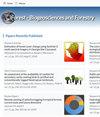Strong relationships between soil and vegetation in reference ecosystems of a riparian Atlantic rainforest in the upper Doce River watershed, southeastern Brazil
IF 1.7
4区 农林科学
Q2 FORESTRY
引用次数: 0
Abstract
Habitat loss and fragmentation have been impacting ecosystem services essential for human survival. The Brazilian Atlantic rainforest, a biodiversity hot-spot, has suffered from historical deforestation and, more recently, from an environmental disaster caused by the Fundão dam collapse that released ore tailings drastically affecting a large territory in the Doce River watershed. This work aims to assess the relationships between soil properties and vegetation in a reference ecosystem to provide guidelines for restoration projects in areas affected by the dam collapse. We conducted phytosociological (vegetation characteristic) and soil quality studies in three distinct natural sites and studied different vegetation strata to better understand plant species composition in reference sites along the impacted Doce River and their potential role in community structuring and functioning. We recorded 140 species, 78 in the tree stratum, and 90 in the sapling stratum. Furthermore, our results highlight the influence of soil on floristic composition in the Atlantic rainforest. Small-scale edaphic variation influenced species composition in both sapling and tree strata. We also identified species of the same genus with strong association with the extremes of the edaphic gradient. Therefore, we highlight that studies in various regions along the Doce River watershed are of utmost importance to evaluate the association between species and soils. The particularities of the species are crucial to the effectiveness of restoration processes since this plant-soil correlation should not be extrapolated even within the same genus. This knowledge is of strategic relevance to provide scientific-based guidance for restoring these environments, aiming at the recovery of biodiversity and ecosystem services.巴西东南部多塞河上游大西洋沿岸雨林参考生态系统中土壤与植被之间的密切关系
栖息地的丧失和破碎化已经影响到对人类生存至关重要的生态系统服务。巴西大西洋雨林是一个生物多样性的热点地区,历史上曾遭受过森林砍伐,最近又遭受了fund o大坝坍塌造成的环境灾难,该大坝释放的尾矿严重影响了多塞河流域的大片地区。本研究旨在评估参考生态系统中土壤特性与植被之间的关系,为受溃坝影响地区的修复工程提供指导。为了更好地了解多斯河沿岸参考点的植物物种组成及其在群落结构和功能中的潜在作用,我们在三个不同的自然样地进行了植物社会学(植被特征)和土壤质量研究,并研究了不同的植被层。共记录到140种,乔木层78种,幼树层90种。此外,我们的研究结果强调了土壤对大西洋雨林植物区系组成的影响。小尺度的土壤变化对幼树层和乔木层的物种组成都有影响。我们还发现了与极端地形梯度密切相关的同一属物种。因此,我们强调在多泽河流域的不同区域进行研究对于评估物种与土壤之间的关系至关重要。物种的特殊性对恢复过程的有效性至关重要,因为即使在同一属中,这种植物-土壤相关性也不应该被外推。这些知识具有战略意义,可以为恢复这些环境提供基于科学的指导,旨在恢复生物多样性和生态系统服务。
本文章由计算机程序翻译,如有差异,请以英文原文为准。
求助全文
约1分钟内获得全文
求助全文
来源期刊

Iforest - Biogeosciences and Forestry
FORESTRY-
CiteScore
3.30
自引率
0.00%
发文量
54
审稿时长
6 months
期刊介绍:
The journal encompasses a broad range of research aspects concerning forest science: forest ecology, biodiversity/genetics and ecophysiology, silviculture, forest inventory and planning, forest protection and monitoring, forest harvesting, landscape ecology, forest history, wood technology.
 求助内容:
求助内容: 应助结果提醒方式:
应助结果提醒方式:


